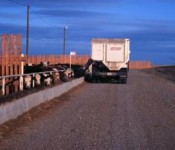Using wheat as an energy source for beef cattle

In a study published in the November 2014 issue of the Journal of Animal Science (“Impact of hard vs. soft wheat and monensin level on rumen acidosis in feedlot heifers”) researchers in Canada conducted a metabolism trial using fistulated beef heifers to determine whether different types of wheat grain could be fed as an alternative energy source.
Dr. WenZhu Yang, a research scientist at the Agriculture and Agri-Food Canada—Lethbridge Research Centre, and colleagues determined whether soft wheat versus hard wheat might ferment at different rates and, therefore, have different values for feeding beef cattle. They also evaluated the effect of feeding more monensin (an ionophore used to improve feed efficiency and prevent or control coccidiosis) than the current practice, Yang indicated.
“The evaluation of these dietary factors was investigated by measuring ruminal pH and rumen fermentation, microbial protein synthesis in the rumen, and the site and extent of nutrient digestion by finishing beef heifers,” Yang said.
The researchers found that wheat can be fed at more than 50 percent of dietary dry matter without adversely impacting the feeding value of the wheat grain, Yang said. Beef producers need to pay attention to grain processing to ensure that ruminal starch digestion is not too fast, Yang said, which could result in subclinical ruminal acidosis or adversely impact animal health and growth performance.
The researchers also found that increasing monensin supplementation decreased feed consumption and increased propionate in the ruminal fermentation pattern, Yang said. Greater monensin feeding suggests a potential for improving feed efficiency.
“However, other factors such as proper feed adaptation, bunk management, and increasing the level of silage in the diet may also be effective management strategies,” Yang said.
Yang said he and his colleagues plan to further their research by determining the optimum processing of wheat grain. They are also developing near-infrared spectroscopy calibrations that will take composition and digestion rate into account.
Media Contact:
Kim Schoonmaker
ASAS Media Communications
kims@asas.org
Scientific Contact:
Larry Reynolds
ASAS Media Communications
Larry.reynolds@ndsu.edu
Media Contact
More Information:
http://takingstock.asas.org/?p=13782All latest news from the category: Agricultural and Forestry Science
Newest articles

Webb captures top of iconic horsehead nebula in unprecedented detail
NASA’s James Webb Space Telescope has captured the sharpest infrared images to date of a zoomed-in portion of one of the most distinctive objects in our skies, the Horsehead Nebula….

Cost-effective, high-capacity, and cyclable lithium-ion battery cathodes
Charge-recharge cycling of lithium-superrich iron oxide, a cost-effective and high-capacity cathode for new-generation lithium-ion batteries, can be greatly improved by doping with readily available mineral elements. The energy capacity and…

Novel genetic plant regeneration approach
…without the application of phytohormones. Researchers develop a novel plant regeneration approach by modulating the expression of genes that control plant cell differentiation. For ages now, plants have been the…





















